#L. pulmonaria
Photo

Tree lungwort
Lobaria pulmonaria
Eagle River Nature Park, Malakwa, BC
16 Sep 2022
#lungwort#tree lungwort#Lobaria pulmonaria#L. pulmonaria#lichen#lichenized fungus#photography#macro#macrophotography
2 notes
·
View notes
Text

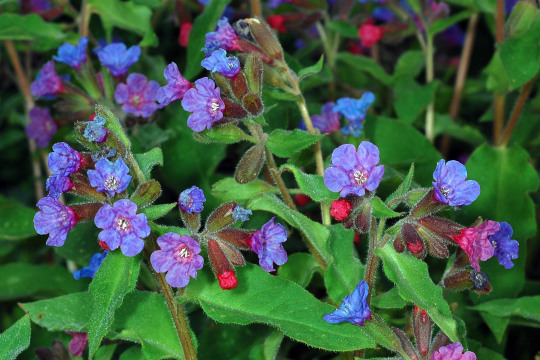

P – Pulmonaria hirta L. – Polmonaria irta (Boraginaceae)
68 notes
·
View notes
Text
Lichen anatomy lesson
SO I was reading through this week’s paper for my lab meeting, and I noticed it had some great visuals that explain the internal anatomy of the lichen thallus--specifically for this paper, Lobaria pulmonaria. So, here is what we see with the naked eye:

Lobaria pulmonaria is a large, foliose lichen that grows in undisturbed, old growth forests. It is a symbiotic association between an ascomycete fungus (the mycobiont), a photosynthesizing green algae (the primary photobiont), and a nitrogen-fixing cyanobacteria (the secondary photobiont). This means that L. pulmonaria is what is known as a tripartite lichen, which is pretty unique in the lichen world. If you were to cross section one of these leaf-like lobes and look at it under the microscope, here is what it would look like:

You can clearly see the structural and protective layers of fungal tissue in the upper and lower cortices and medulla, the green algal cells in the primary photobiont layer, and the cyanobacterial colonies encapsulated in the cephalodia. You can also see the tomentem. These little strings look like roots, but don’t absorb water or fix nitrogen like roots do--they just anchor the lichen to the substrate.
But let’s get even more granular:

In this schematic, you can see other members of the symbiotic community, including bacteria and lichenicolous fungi (I think it is important to note here that every living organism has colonies of associated bacteria and fungi. This is not unique to lichens). You can also see the structures that encapsulate the cyanobacteria, and as well as the make-up or soredia (vegetative reproductive propagules) containing both fungal and algal components.
Now I know some of you guys might be wondering why L. pulmonaria has 2 photobionts when many lichens get by with just 1. Well never fear, my symbiotic associates. I will let you know in a future lichen lesson, but for now enjoy these gorgeous graphics and bask in the glory of the lichen.
Grimm, M., Grube, M., Schiefelbein, U., Zühlke, D., Bernhardt, J., & Riedel, K. (2021). The lichens’ microbiota, still a mystery?. Frontiers in Microbiology, 714.
#lichen#lichens#lichenology#lichenologist#lichenized fungus#symbiosis#mutualism#biology#ecology#mycology#microbiology#algae#cyanobacteria#nature#the natural world
400 notes
·
View notes
Text
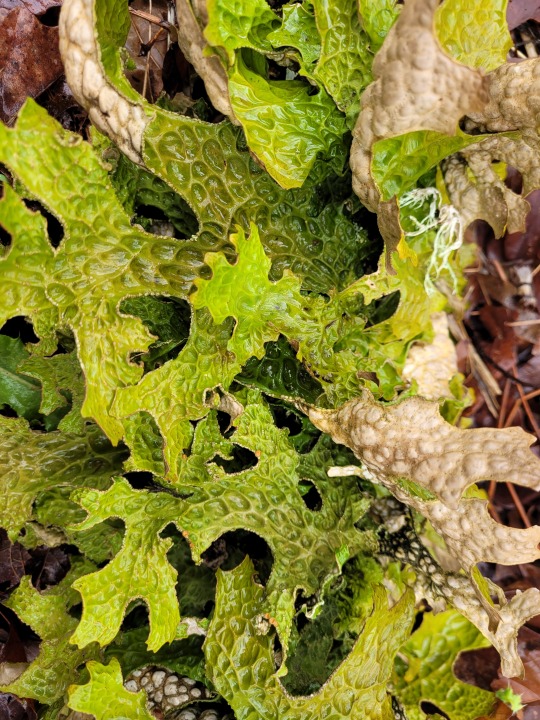
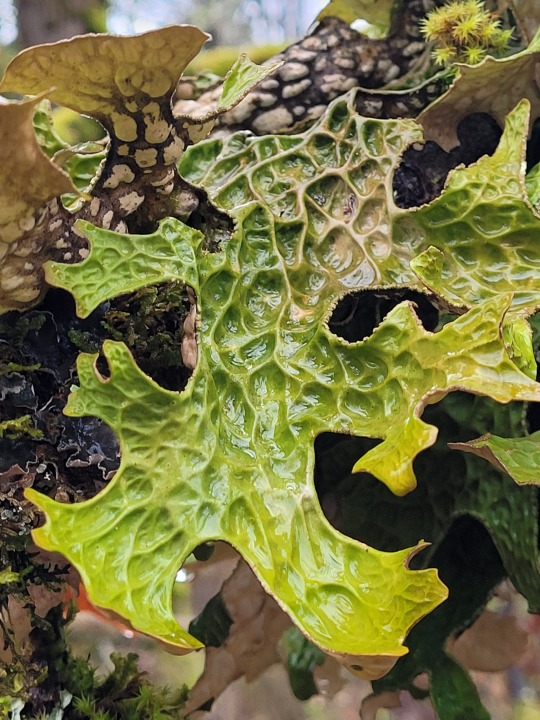

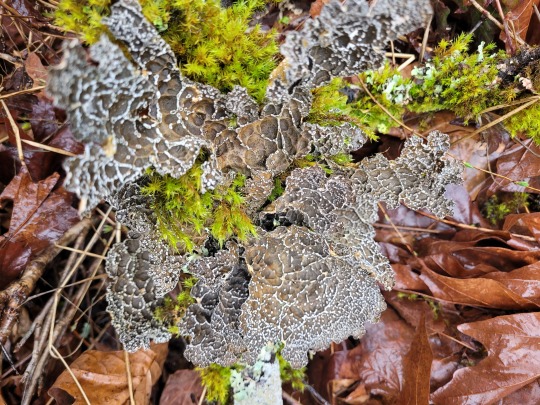
Lobaria pulmonaria (Tree Lungwort)
Lobaria anomala (Netted Specklebelly)
South-eastern Vancouver Island, BC, Canada. March 8, 2024.
I'm always excited to see Lobaria sp. because they do not grow (or are very rare) in the places I lived in (and they are beautiful, huge lichens, too!). And this is my first time seeing L. anomala.
1 note
·
View note
Text
Fwd: Graduate position: Munich.LichenAdaptations
Begin forwarded message: > From: [email protected] > Subject: Graduate position: Munich.LichenAdaptations > Date: 21 May 2022 at 08:13:39 BST > To: [email protected] > > > > PhD position: “Genetic adaptations and mechanisms of stress tolerance in > green-algal lichen photobionts and their host fungi” > We seek applicants to perform thesis research on how green algal lichen > photobionts are able to tolerate stressful conditions and to study > genetic adaptations of individuals and populations. Applicants must have > the ability both to work independently and to integrate in a team > environment. They are expected publish their results in well-respected > peer-reviewed journals. Applicants should hold a MSc degree or > equivalent in a program providing experience in evolutionary biology, > systematics, ecophysiology or similar. Essential are German language > skills. Experience with fungi or green algae is desirable, and > candidates possessing this experience will rank higher. Advantageous are > skills in R and python. > > Salary and benefits are in accordance with a public service position in > Germany (collective agreement TV-L E13, 50%). The position includes a > teaching duty of 2.5 hours per week during the semester. The contract > shall start in October (negotiable) and will be limited to 12 months, > with a possibility for extension by up to 2 years. Equally qualified > handicapped applicants will be given preference. > > Our major research areas are population genetics, systematics and > ecology of symbiotic fungi and their photosynthetic partners. The core > study systems of our research group is the model lichen lungwort > (Lobaria pulmonaria). Lungwort is an epiphytic lichen which has been > well studied regarding its ecology and dispersal biology. Extensive > genome sequence datasets are available for lungwort, including multiple > annotated genomes of the mycobiont and of its primary photobiont. > > The candidate's workplace will be located near the premises of the > beautiful Botanical Gardens of Munich in Nymphenburg. With its > picturesque old town, Nymphenburg castle, its vivid green spaces such as > the forests along the Isar river, the English Garden, numerous beer > gardens and an active night life, Munich is arguably one of the cities > with the highest life quality in Germany. Being located proximate to the > Alps, Munich moreover provides interesting opportunities as a location > both for biological studies and for various recreational activities. > > Applications consisting of a CV, publication list, possible starting > date, and a statement of research interests (maximum 1 single-spaced > page in length), names and contact information for up to three > references should be prepared in a single pdf file and sent by email to > Silke Werth at [email protected] with subject line “PhD position Genetic > adaptations and mechanisms of stress tolerance”. Review of applications > will start June 20th, 2022, but applications will be accepted until a > suitable candidate has been found. The position is available from > October 2022. > > Information on the research environment at LMU Munich can be found here: > www.en.biologie.uni-muenchen.de. Information on relocation to LMU > Munich is available here: > https://ift.tt/5KJ8mln > > > Prof. Dr. Silke WERTH > LMU Munich > Systematics, Biodiversity and Evolution of Plants > Menzingerstraße 67, 80638 Munich, Germany > Email: [email protected] > > > Werth >
via IFTTT
0 notes
Text
Lungwort
Pulmonaria officinalis (lungwort) is known since medival times (was used by Hildegard von Bingen, Paracelsus).
It can help with: cystitis, diarrhea, colds, sore throat, hoarseness, cough, pneumonia, wounds, asthma, common cold
Properties: astringent, diuretic, soothing
Harvesting months: February-July
Usable parts: leaves, blossoms, roots
Flower color: blue, pink, violet
Locations: light forests, brooksides, wet meadows, gardens
Culinary use: (edible, nontoxic) as wild vegetable, can be used in salads, soups, smoothies, flowers as decoration in desserts
(Not reccomended during pregnancy. Not reccomended using long-term.)
Usage: as tea, 2tsp lungwort, add 250ml hot water, let rest for 8-10 min, drink 3 cups a day
Lung herb has an abirritant effect, you can use also it with ribwort and honey. For a tea you need 30 g lungwort, 20 g ribwort leaves and 1 tsp honey. The herbs are mixed and you add boiling water (1/2 l for 4 tsp of the mixture). After 10 minutes, stir in the honey. Drink hot throughout the day.

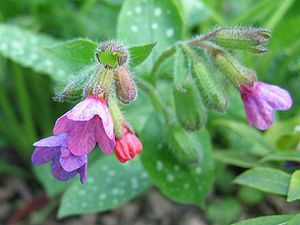
#herbology#herbs#medicine#naturalmedicine#kräuter#kräutermedizin#nature#plants#herbal#lungwort#pulmonaria#Lungenkraut#Medizin#Heilen#natürlich#Pflanzen
7 notes
·
View notes
Text
Testing times
World events are affecting us all in some way or another, some more seriously than others. I am now at home for the foreseeable time. It’s not ideal, but absolutely necessary.
Potted Daffodils in the sunshine
The garden has dried out enough for some light tiding to take place, Sunny, but cool days have prompted a growth frenzy and it’s very welcome during these tough times. Bulbs I purchased last Autumn but were unable to plant in the ground due to swamplike conditions are flourishing in pots dotted throughout the garden.

Anemone Blanda
I’ve had one of my best displays of Anemone Blanda for a long time, I’m not sure if it was the mild winter or incessant rain that they preferred, but they are a cheery sight.
Long Border drying out
My new plantings of Pulmonarias have largely come through the winter unscathed, there have been a couple of casualties, I can see lonely plant labels with no plants present, but when the border dries out a bit more I’ll venture in and make a list of who expired, I still have plants I did not get round to planting late last year, again due to the almost daily rain not much gardening took place since last mid-October.
I’m in no rush, I have time on my hands now, but I’m also aware it’s still only the end of March, and we are waking up to almost daily frosts, so I’m holding back on any big seed sowings. Around about now I would have been on my way to the U.S.A and had intended to make seed sowings on my return.
My Hellebores and Magnolia × loebneri ‘Leonard Messel’, are in full flower and looking bright, the Island bed is covered in Tulip growth with the promise of lots of flowers. I did not bother digging up any of my Dahlias last autumn, again due to the rain, I decided to let them take their chances and I will be interested to see if any shoot when it gets warmer. There will no popping to the shops to replace them though.
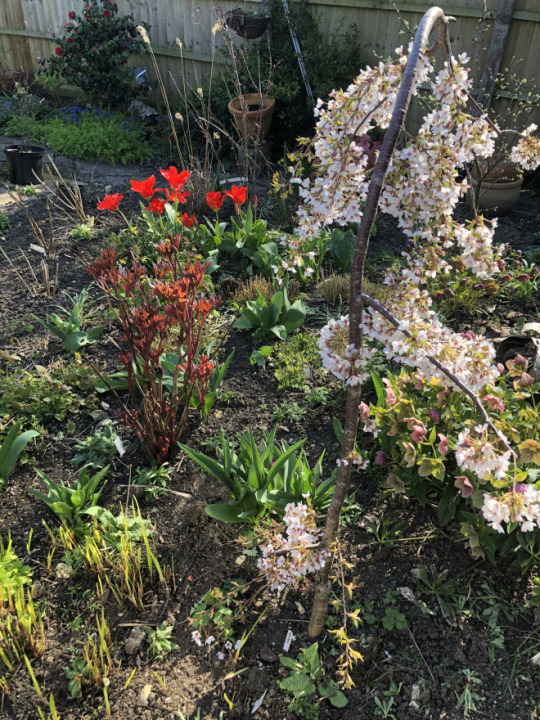
Prunus Iford Cherry
My Iford Cherry is looking better after recent years of poor performance stuffed in an unsuitable pot. I planted it out last Autumn and hoped for the best. It’s looking blooming and will hopefully thrive from now on.
Paeonia Pink Hawaiian Coral…It’s not Dead.!
Recently I made a pleasing discovery, when attending the Garden Press Event in 2019 I was given a division of a Paeonia plant called Pink Hawaiian Coral from Clare Austin Hardy Plants to celebrate the anniversary of the nurseries founding, I potted up the plant and grew it on and then planted it out when it was a bit bigger, unfortunately, it got brown blotches on the leaves and appeared to suffer from a fatal fungal attack, l pulled out the remains late last year thinking that was that, but this week there are signs of a green healthy leaf.
So perhaps all is not lost. I’ll keep you updated on its progress.

Bright coloured flowers for darker times
Testing Times Testing times World events are affecting us all in some way or another, some more seriously than others.
#Hellebores#Magnolia × loebneri &039;Leonard Messel&039;.#narcissus tete a tete#Paeonia Pink Hawaiian Coral#Prunus Iford Cherry#Spring#Spring Flowers
1 note
·
View note
Text
Lung herb.
As to walk in spring and to see a primula is very wonderful time,as other name her pulmonaria, lung plant.And its a true remedy for breath, as asthma, pneumonia, or bronchitis. And of course to the base cure. Primula blooming since March till May and having a half table by Mendeleev,as micro elrements, and she having healing, anti septic, anti inflamed effect and ability to blood creation. A best cure for breath is spirit infusion of primula, as 50 gr of dried herb add in jar of glass,add 600 ml. vodka, or diluting till 40 gr spirit, infuse for 2 weeks, shaking, use one tea.sp. for 3 times a day before meal. Course are three months with week rest after every 30 day a using.And care use her as in pregnancy, leucosis with, bad enduring a plant, thus better not use.
Chelidonius and oil.
Am sharing recipe which am success used ,as on 1962 my hubby as on 25 y.old three times had lung inflammations and a diagnosis put as nidus bilateral,and we lived in Primorski edge, and doctors advised for him a faster climate change,so we are moved in Toljati,as he used cure, but he not used pills,he feared,and worsening health after , thus am used recipe,which my friend used. As on a blooming time Chelidonius as on May/June or September/October use his with roots, clean, leafs, wash are they good, apply for dry on towel , as give juice, thus apply old towel, but not felled,And after to mince meat , but not use elector, and mass press, juice add in spirit,as 70 perc. juice plus 30 perc. spirit,keep in dark bottle of glass in refrigerator. And use one tbl.sp. for 3 times a day before meal, and after eat 20 gr salt free butter oil,and a course is depends from a condition and recovering, my hubby used one month, and since he is not sicked, he lived till 75 y.old, and dead of stroke on 2012.
Hazelnut infusion. Am preparing hazelnut twigs and chopping on 10 cm,add in pot, of enamel, as on ten cm of layer and put on strong fire in closed lid, in boiling water , low fire and keep infusion stew for three hours, and from put water evaporating as ten cm in size. As after am cooling infusion, put legs in pot and keep till a cooling,after dry rub theirs and with a brush remove a hard skin layer, as after this cure from legs are fallen oedemas, aches stopped,stars removed as bruises of veins ruptures,and infusion using a few times as keep in pot in cool place,after warm, and again put legs.
Longevity recipe.
As this mixture strengthening immune system, improving memory, and heart work,and effectivity for blood vessels cleaning.
0.5 l. of honey, 200 gr of sprouts millet, 8 lemons, 200 of walnuts, 6 heads garlics.For millets sprouts receiving,you are for 12 hours adding warm water millet, wash after, add in jar for 24 hours, when seeds are grown, you can cook a remedy,as to chop all ingredients in blender. And lemons good wash,and with peel to mince meat, and mix all, add in jar of glass and for three days put in cold, use one tbl.sp. for4 times a day before meal.
Helped are black radish with burdock.
As am healed waist aches by my friend s advices as formed a scarf,like kerchief and applied leafs of black radish and burdock,and beaten theirs till moisture,after a second half of kerchief covered a first and applied to waist,wearing after a sporty tricot and with compress am stayed for three days, and aches stopped. As my neighbour also felt hurt,and used my cure,and later she run through a garden am asked her and how is she? She answered,that helped..
via Blogger https://ift.tt/3dz5a1M
0 notes
Text
Osmanthus Burkwoodii | Hedge Plants
And my final Spring Star is Brunnera macrophylla ‘Alexander’s Great’ (Siberian Bugloss). Some of you may know and curse the more usual brunnera which can make itself a lot too comfortable, certainly down here in Eastbourne. ‘Alexander’s Great’ is a much more refined version, sporting sprays of starry blue forget-me-not flowers in spring and beautiful large netted white leaves for the summer and autumn. SO much easier than Hostas – the snails don’t touch it! – and just as satisfying in a part-shaded spot.
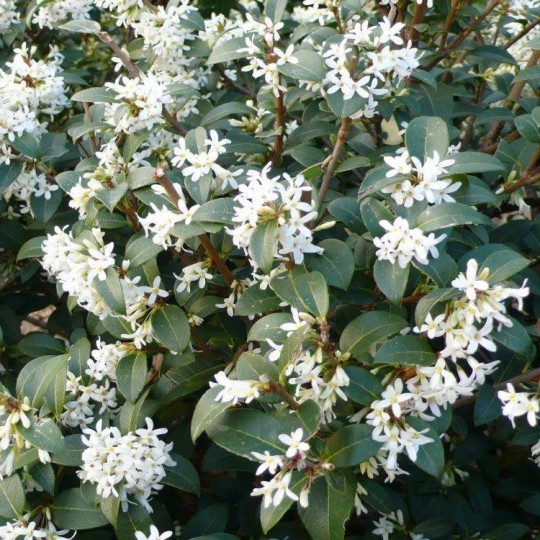
I won’t be saying ‘no’ to the champers of course, but in Scotland we like to keep our feet on the ground and I have nothing but praise for the sturdy, evergreen shrub Osmanthus burkwoodii, described as ‘dense and slow-growing’ (L & E spring to mind) nevertheless it stoically produces lovely, scented white flowers at this time of the year. And despite a persistently cold wind it shows none of the ugly windburn which blights the cistus rose and viburnum tinus beside it in my garden. A top performer.
Far more tactile, pulsatillas would be my next choice. I love stroking their downy ‘teddy bear’ leaves as they develop, their flowers are divine, followed by delightful fluffy seedheads, and…..you’ll find you value this once you reach 60….they’re yearly dependable. Now if I’m making other flippertygibbet plants like trilliums or meconopsis feel uncomfortable when I say that, well, if the cap fits wear it (you’ll also find you sound more and more like your mother).
An iron clad shrub for western Oregon. It endures heavy clay soils, summer drought and the coldest temperatures we can expect with no harm. Dapper evergreen shrub Osmanthus burkwoodi with handsome matte green leaves. In February and March masses of small tubular white fragrant flowers crowd the stems and emit the perfume of vanilla. Very drought tolerant but adaptable to regular irrigation as well. Avoid permanently wet sites. To 7′ x 7′ in 7 years. Tolerates subfreezing wind and is useful as a hedge/windbreak in areas exposed to gorge outflow. Blooms on wood from the previous season prune- if needed after flowering. Tolerates quite a bit of shade. Very old specimens become exotic looking evergreen trees with umbrella shaped clouds of foliage.
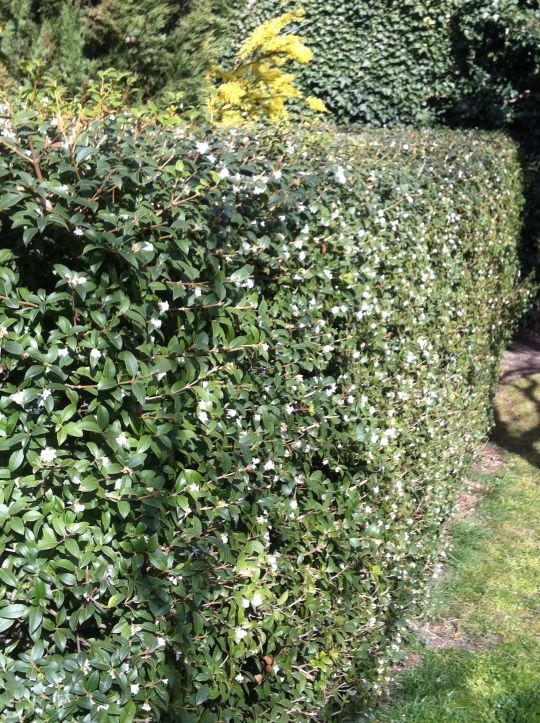
A simple cottage garden favourite like Pulmonaria officinalis (lungwort) can make a partly-shaded corner sing with color in April. The bees love the mauve and pink flowers and their spotted leaves resemble little lungs, hence their Latin and English names. Anything with ‘officinalis’ in its name means that it was once used as a medicine – in this case, for lung problems, in fact! They look rather messy after flowering, so take the whole flower-stalk off and any tatty leaves, water it, and it will renew itself as a neat and attractive mound of leaves very quickly. Powers of recovery I could do with, frankly, after a night out with my Bookclub Girls.
0 notes
Text
Consejos para tratar un resfriado de forma natural
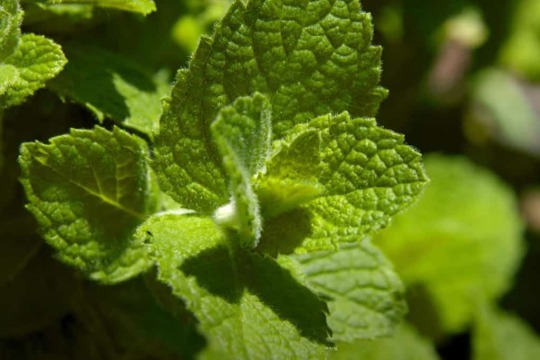
Nariz tapada, estornudos, secreción nasal, a veces dolor de cabeza o tos: los síntomas del resfriado son molestos pero no graves. Aerosoles nasales, hierbas, aceites esenciales… ¿cuáles son los remedios de la abuela o soluciones naturales para tratar un resfriado de forma natural?
Sin tratamiento, los síntomas del resfriado desaparecen espontáneamente en siete o diez días. ¿Qué se puede hacer para detener rápidamente el resfriado y evitar complicaciones sin el uso de medicamentos de pseudoefedrina de venta libre? Estas gotas y sprays fríos que contienen vasoconstrictor son controvertidos porque pueden causar serios efectos secundarios cardíacos y neurológicos.
Lavado nasal
A la primera señal, te lavas la nariz. Esto facilita el sonarse la nariz y elimina un máximo de gérmenes. Se prefieren las soluciones ricas en minerales y oligoelementos, como el agua de mar, para optimizar el funcionamiento de las células ciliadas de la mucosa nasal, las primeras barreras a los virus.
Se utiliza un aerosol isotónico, con una concentración de sal idéntica a la de los fluidos corporales (9 g/l), tantas veces como sea necesario. Puede elegirse enriquecido con cobre, antiinfeccioso o azufre, también antiinflamatorio y “reparador” de la mucosa nasal.
Si la nariz está bloqueada, optamos por un spray hipertónico. Las soluciones hipertónicas aceleran la descarga nasal. Útiles si la sensación de nariz tapada es molesta, son sin embargo irritantes porque son ricas en sal (generalmente 22 g/l): por lo tanto, sólo se utilizan durante algunos días. Algunos contienen aceites esenciales de menta o eucalipto que también son descongestionantes pero no son adecuados para niños pequeños.
Inhalación
Si la obstrucción nasal es importante, pasamos a las inhalaciones de aceites esenciales (ravintsara, tomillo, eucalipto, menta…). El vapor de agua caliente dilata los pequeños vasos y optimiza la acción antiinfecciosa y descongestionante de los aceites esenciales, lo que produce un efecto rápido.
Dado que una gran cantidad de principios activos llega a las vías respiratorias hasta los tubos bronquiales, estas inhalaciones también son útiles en caso de tos.
Plantas para tratar un resfriado y calmar el moqueo
Algunas plantas ayudan a la curación. Se utilizan en el tratamiento de resfriados y en medicamentos.
Este es el caso de la equinácea púrpura y el pelargonio, para ser usado al comienzo del resfriado. El pelargonio se recomienda en forma de extracto seco (generalmente 20 mg 3 veces al día en adultos) y puede utilizarse a partir de los 6 años de edad.
Otra planta interesante, el saúco negro, con propiedades antivirales y antiinflamatorias. Se utiliza en dosis de 200 a 400 mg por día de extracto seco de bayas. El té de bayas de saúco abre la nariz tanto a los adultos como a los niños. Cuente un pellizco para una taza, para ser tomada cuatro veces al día. La baya del saúco es una planta conocida por sus propiedades antivirales y antiinflamatorias.
Para detener naturalmente el goteo nasal, el fitoterapeuta aconseja aceite esencial de menta, descongestionante y astringente. Aprieta la membrana mucosa. En los adultos, aconsejo que se tome una gota, de cuatro a seis veces al día, con miel. Puede ser útil beber un vaso de agua tibia después.
En caso de estornudar, el plátano puede utilizarse como té de hierbas (una cucharada para un tazón, dos veces al día) o como extracto fluido vegetal estandarizado (PES): una cucharadita dos o tres veces al día para un adulto. En un niño: un mililitro (ml) para diez kilos de peso por día.
Por favor, tenga en cuenta que estos productos no deben ser utilizados en niños menores de siete años de edad!
Remedios homeopáticos para el goteo nasal
Para un escurrimiento claro, una nariz de fuente y estornudos repetidos que mejoran al aire libre, sugiero Allium cepa 9 CH, cinco gránulos cuatro veces al día. Si, por el contrario, los estornudos empeoran con el frío: Nux vomica 9 CH, cinco gránulos cuatro veces al día”.
Para descargas gruesas, el Kallium bichromicum 5 CH, la misma dosis.
Remedios homeopáticos para la congestión nasal
Para una nariz bloqueada que no permite respirar y amenaza con convertirse en sinusitis, con dolor en la raíz de la nariz, Sticta pulmonaria 5 CH, cinco gránulos cuatro veces al día.
Si la nariz está bloqueada por la noche y se pone amarilla durante el día: Pulsatilla 9 CH, cinco gránulos por la mañana y por la noche.
Si la situación no mejora después de dos o tres días de automedicación y el resfriado no desaparece, y mucho menos la fiebre, es mejor consultar a un médico.
from WordPress https://homeopatiaynaturopatia.com/consejos-para-tratar-un-resfriado-de-forma-natural/?utm_source=rss&utm_medium=rss&utm_campaign=consejos-para-tratar-un-resfriado-de-forma-natural
0 notes
Text
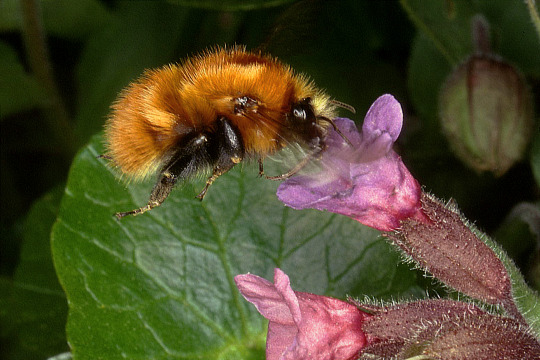
Bombus pascuorum in visita ai fiori di Polmonaria maggiore (Pulmonaria officinalis L., Boraginaceae)
#photographers on tumblr#digital image processing#original photographs#flowers#Boraginaceae#Bombus#pollination
7 notes
·
View notes
Text



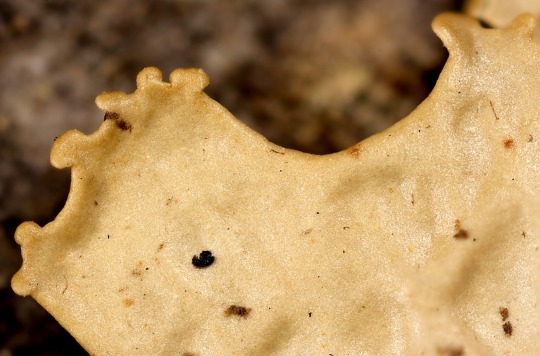
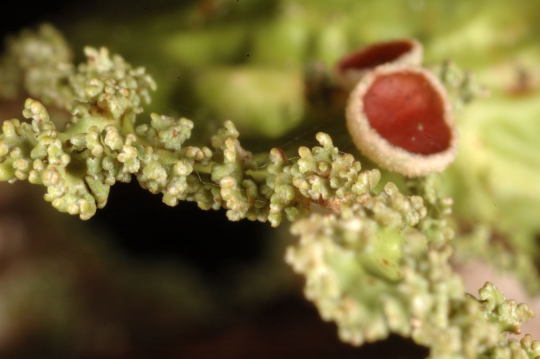

Lobaria immixta
Ah yes, that awkward moment when you are looking up information on a lichen, and your supervisor is an author on all the foremost papers on it. We do constantly have Lobaria lichens laying around the office so it's not like I am that surprised, but still. Sad that this lichen post is scheduled for the holidays when I can't ask her about it, but oh well. I can read her papers! L. immixta is a foliose lichen that grows on trees in humid, old-growth forests in Macronesia. It looks very similar to its 2 sister species, L. pulmonaria and L. macronesica, which share large lobes with a lung-like texture, bright green coloration, and bright orange-red apothecia. It's distinctive features is that it forms flat, scale-like propagules along the edges of the lobes--like little mini leaves along the margins of the main leaf. The underside of the lobes are white, with brown venation in the textured grooves. A rare and beautiful friend who I will have to look at when I get back to the lab. Jealous? I mean probably not, but you should be.
images: source | source
info: source | source | source
#lichen#lichens#lichenology#lichenologist#lichenized fungus#fungus#fungi#mycology#ecology#biology#systematics#taxonomy#life science#environmental science#natural science#nature#naturalist#beautiful nature#weird nature#the natural world#Lobaria immixta#Lobaria#I'm lichen it#lichen a day#daily lichen post#I love lichens#lichens are so good#see the forest for the lichens#trypo#trypophobia
85 notes
·
View notes
Text
5-12 April 2020
I made good progress on the database this week. In addition to the 800 or so scans of florilegium paintings, I also have a treasure trove of photos that gardeners and volunteers have taken, that need to be uploaded. Wednesday I discovered a file with more than 300 photos of snowdrops from 2016. They are now all in the database. It’s so nice to be able to see photos and drawing of the diverse collection of plants in the garden. I was especially happy to see that an orchid in the tropical corridor that I’ve been nursing, did bloom in 2015. I have renewed inspiration to get it to bloom again.
With the reduced air traffic, I’m able to enjoy the sounds of nature, the birds singing and the rustling of leaves in the breeze. However, my tinnitus, which I have in both ears, 24/7/365, is also more prominent and has been quite disturbing for the past few weeks. I don’t know if the background stress of what’s going on triggered something or not. I also don’t know if it’s what’s causing me to have frequent headaches. I hope one day it either goes away on its own or someone figures out how to stop it.
At home, neighbours have created a WhatsApp group and daily there are messages offering to go shopping, or requests for voluneering. One day last week we answered a call to made 30 masks for the NHS. Initially the request was to make 45, however, the response was so great that we only needed to make 30 each. As as a street, I believe we made 1,000. Next week we’ve been asked by the hospital we donated the first batch to for more. So I believe next week’s goal is 4,000. It was great to hear the hospital liked them.


In the garden at home I tied up the climbing roses and the wisteria. I’m looking forward to the wisteria, there are a lot of buds and it should produce quite a show. The rhododendron is performing well at the moment too.

We completed anther puzzle and there is another lying in waiting. Kitty and Ann decorated some hazel branches I cut from the garden to create this beautiful Easter tree.

We’ve been enjoying amazing meals the past few weeks, some of the highlights were a lamb tajine, roast guinea fowl with cheesy mash, Anne’s ratatouille with meatballs, mushroom and courgette pasta, gigli pasta with black chickpeas and za’atar, black rice mushroom stroganoff and spanakopita.
Plant of the week
Boraginaceae Pulmonaria officinalis L.

common name(s) - lungwort, common lungwort, Mary's tears, Our Lady's milk drops, Jerusalem sage, Adam and Eve, Bedlam cowslip, beggar's basket, bugloss cowslip, Jerusalem cowslip, lady’s cowslip, lady’s milk, Mary’s honeysuckle, sage of Bethlehem, soldiers and sailors, spotted dog, Virgin Mary's honeysuckle
synonym(s) - Pulmonaria alpina Mill.; P. gallorum Gueldenst.; P. maculata F.Dietr.; P. tridentina Evers
conservation rating - Least Concern
native to - Europe
location - garden at home
leaves - basal leaves are green, cordate, more or less elongated and pointed and always with rounded and often sharply defined white or pale green patches; upper surface has tiny bumps and it is quite hairy
flowers - small bunches, red or pink at first, later turn to blue-purple during the anthesis, by changing the pH value inside of the petals; the flowers contain a dye that belongs to the anthocyanins and change the colour from red (acidic) to blue (alkaline).
habit - herbaceous, rhizomatous, semi-evergreen perennial to 300mm tall
habitat - damp open woodland, including oak, hornbeam, lime, sycamore and beech woods, and is also found scrub, found from lowlands to mountain areas
pests - generally pest-free
disease - powdery mildews
hardiness - to -20ºC (H6)
soil - prefers nutrient rich alkali soils
sun - part shade to full shade
propagation - division after flowering or in autumn
pruning - remove old leaves after flowering
nomenclature - Boraginaceae - borago - shaggy-coat, burra with feminine suffix (the leaves); Pulmonaria - meaning lung and was first used by Leonhart Fuchs (1501-66), a German physician and one of the three founding fathers of botany; officinalis - of the apothecaries, officinal medicines
NB - used since the Middle Ages to treat coughs and diseases of the chest, because of the doctrine of signatures whereby Christian doctors believed that plants that resemble any body part could be used to treat illnesses in this part since God put his signature in the plant to guide mankind.
References, bibliography:
Gledhill, David, (2008) “The Names of Plants”, fourth edition; Cambridge University Press; ISBN: 978-0-52168-553-5
IUCN [online] https://www.iucnredlist.org/species/202970/2758321 [10 Apr 20]
Plant List, The [online] http://www.theplantlist.org/tpl1.1/record/kew-2413004 [10 Apr 20]
Plants of the World [online] http://plantsoftheworldonline.org/taxon/urn:lsid:ipni.org:names:120402-1 [10 Apr 20]
Royal Horticultural Society [online] https://www.rhs.org.uk/Plants/14153/Pulmonaria-officinalis/Details [10 Apr 20]
Wikipedia [online] https://en.wikipedia.org/wiki/Pulmonaria_officinalis [10 Apr 20]
CoVid-19 update

0 notes
Photo

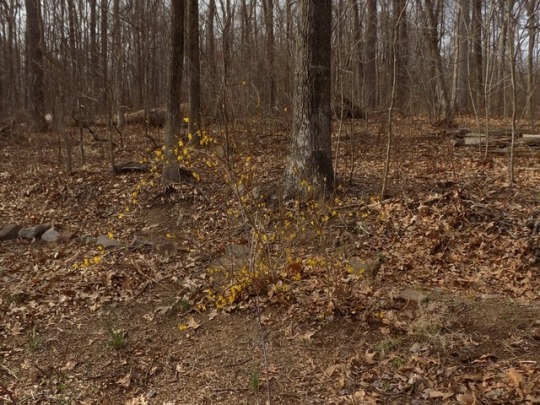

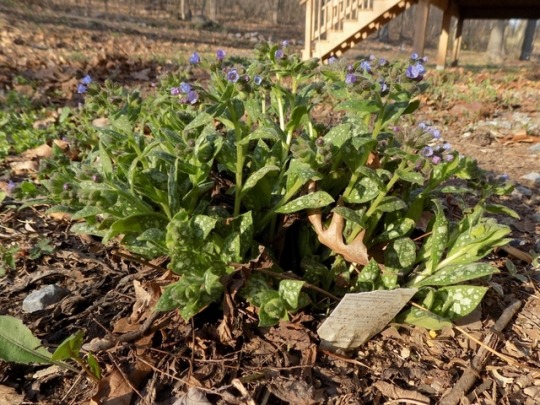

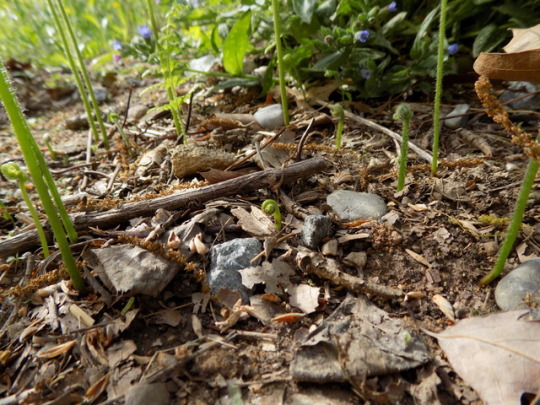


in order of appearance III: shrubs, vines, and late spring perennials
Spicebush (Lindera benzoin)
Forsythia (Forsythia)
Ground ivy (Glechoma hederacea L.)
Lungwort (Pulmonaria saccharata)
Periwinkle (Vinca minor)
Fiddlehead fern (Matteuccia)
Azalea (Rhododendron)
Lily of the valley (Convallaria majalis)
#perennials#woody perennials#shrubs#vines#spring flowers#Pollinator Habitat#pollinator garden#spicebush#forsythia#ground ivy#lungwort#periwinkle#vinca minor#fiddlehead fern#azalea#lily of the valley
3 notes
·
View notes
Text
Fwd: Graduate position: LMU_Munich.ComparativeGenomics
Begin forwarded message: > From: [email protected] > Subject: Graduate position: LMU_Munich.ComparativeGenomics > Date: 21 February 2020 at 07:10:47 GMT > To: [email protected] > > > PhD position available at LMU Munich at the Institute of Systematic > Botany and Mycology (TV-L E13, 50% position) > > We seek applicants with interests and background knowledge in the fields > of Comparative Genomics, Bioinformatics, Population Genomics, Evolutionary > Biology or Fungal Ecology to perform PhD research on comparative > genomics, in order to understand which genomic features have expanded or > diminished in symbiotic taxa, relative to their free-living relatives. > Applicants should have the ability to work independently and publish > their results in well-respected peer-reviewed journals. Applicants are > required to have effective communication skills, both oral and written, > and should be able to work and integrate in a team. > > Basic experience with bioinformatics for genomic analyses is required. R > programming and analytical skills are considered advantageous. Experience > with fungi or algae is desirable, but not required. Advantageous are > skills in python or another programming language. > > Teaching duty includes 2.5 hours weekly during the semester, which can > be taught in the form of supervising BSc and MSc students. > > Salary and benefits are in accordance with a public service position in > Germany (collective agreement TV-L E13, 50%). The contract shall start > as soon as possible and will be limited to 36 months. Equally qualified > handicapped applicants will be given preference. > > Our major research areas are population genetics, systematics and > ecology of symbiotic fungi. The main study systems of our group are the > model lichen lungwort (Lobaria pulmonaria) and other species of the > Peltigerales. Lungwort is an epiphytic lichen which has been studied > extensively regarding its ecology and dispersal biology. Extensive > genome sequence datasets are already available for lungwort, including > multiple assembled and annotated genomes of the mycobiont and of its > primary photobiont, the green alga Symbiochloris reticulata. Our group > has recently sequenced, assembled and annotated the genomes of additional > lichen symbionts. > > The greater Munich area hosts two large Universities and several large > research institutes. Faculty of biology of the LMU is characterized by > a vibrant, international research environment setting the stage for > fruitful collaborations. The candidate???s workplace will be located > near the premises of the beautiful Botanical Gardens of Munich in the > Nymphenburg area. > > With its beautiful old town, green spaces such as the forests along the > Isar river, English Garden, Nymphenburg castle, numerous beer gardens > and active night life, arguably, Munich is one of the cities with highest > life quality in Germany. An interesting feature of Munich is its location > proximate to the Alps, providing interesting opportunities both for > biological studies and for various recreational activities. > > Applications consisting of a CV, publication list, possible starting date, > and a statement of research interests (at least 1 single-spaced page in > length), names and contact information for up to three references should > be prepared in a single pdf file and sent by email to Tanja Ernst at > > [email protected]. Review of applications will start > February 25th 2020, but applications will be accepted until a suitable > candidate has been found. > > Silke Werth > Systematics & Ecology of Cryptogams > Faculty of Biology, LMU Munich > > Menzingerstra??e 67 > > 80638 Munich > Germany > Phone: +49 89 2180 74754 > Email: > [email protected] > > Silke Werth >
via IFTTT
1 note
·
View note
